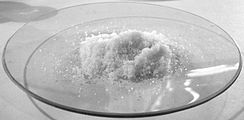This is an old revision of this page, as edited by CheMoBot (talk | contribs) at 11:18, 27 August 2011 (Updating {{chembox}} (no changed fields - added verified revid - updated 'DrugBank_Ref', 'ChEMBL_Ref', 'ChEBI_Ref', 'KEGG_Ref', 'ChEBI_Ref') per Chem/Drugbox validation (report [[Wikipedia_talk:W). The present address (URL) is a permanent link to this revision, which may differ significantly from the current revision.
Revision as of 11:18, 27 August 2011 by CheMoBot (talk | contribs) (Updating {{chembox}} (no changed fields - added verified revid - updated 'DrugBank_Ref', 'ChEMBL_Ref', 'ChEBI_Ref', 'KEGG_Ref', 'ChEBI_Ref') per Chem/Drugbox validation (report [[Wikipedia_talk:W)(diff) ← Previous revision | Latest revision (diff) | Newer revision → (diff)
| |

| |

| |
| Names | |
|---|---|
| IUPAC name Ammonium carbonate | |
| Identifiers | |
| CAS Number | |
| 3D model (JSmol) | |
| ChemSpider | |
| ECHA InfoCard | 100.007.326 |
| E number | E503(i) (acidity regulators, ...) |
| UNII | |
| CompTox Dashboard (EPA) | |
InChI
| |
SMILES
| |
| Properties | |
| Chemical formula | (NH4)2CO3 |
| Molar mass | 96.09 g/mol |
| Appearance | White powder |
| Density | 1.50 g/cm |
| Melting point | 58 °C (136 °F; 331 K) |
| Boiling point | Decomposes |
| Solubility in water | Soluble, decomposes in hot water |
| Hazards | |
| Occupational safety and health (OHS/OSH): | |
| Main hazards | Irritant |
| Related compounds | |
| Other anions | Ammonium bicarbonate |
| Other cations | Sodium carbonate Potassium carbonate |
| Except where otherwise noted, data are given for materials in their standard state (at 25 °C , 100 kPa).
| |
Ammonium carbonate (formerly known as sal volatile or salt of hartshorn) is a commercial salt with the chemical formula (NH4)2CO3. It is used when crushed as a smelling salt. It can be crushed when needed in order to revive someone who has fainted. It is also known as baker's ammonia and was a predecessor to the more modern leavening agents baking soda and baking powder.
Production
Ammonium carbonate was historically obtained by the dry distillation of nitrogenous organic matter such as hair, horn, decomposed primate urine, etc. Currently, it is produced by heating a mixture of ammonium chloride, or ammonium sulfate and chalk, to redness in iron retorts, the vapors being condensed in leaden receivers.
The crude resulting product of either of these processes is Ammonium Polycarbonate: a white fibrous mass with a strong ammonium order composed of a mixture of ammonium carbonate and ammonium bicarbonate. Ammonium carbonate is soluble in alcohol, while the bicarbonate is not. Dissolving the polycarbonate in alcohol, filtering, and evaporating the alcohol leaves just the ammonium carbonate.
The polycarbonate→carbonate and polycarbonate→bicarbonate reactions are "pushed" either way by exposure to ammonia or air, respectively. Ammonia gas passed into a strong aqueous solution of the polycarbonate displaces the hydrogen ion with an ammonium ion, converting it into ammonium carbonate. Exposure of the polycarbonate to moist air does the reverse: it displaces the ammonium ion with a hydrogen ion, converting it to ammonium bicarbonate.
Uses
As well as in smelling salts, ammonium carbonate is still used as a leavening agent in particular recipes, particularly those from northern Europe and Scandinavia. It can sometimes be substituted with baking powder, but the finished product will never be as airy and light as the original recipe. Icelandic loftkökur (air biscuits) for instance cannot be made with anything other than ammonium carbonate.
Its use as a leavening agent, with associated controversy, goes back centuries:
In the third kind of bread, a vesicular appearance is given to it by the addition to the dough of some ammoniacal salt, (usually the sub-carbonate,) which becomes wholly converted into a gaseous substance during the process of baking, causing the dough to swell out into little air vessels, which finally bursting, allow the gas to escape, and leave the bread exceedingly porous. Mr. Accum, in his Treatise on Culinary Poisons, has stigmatized this process as "fraudulent," but, in our opinion, most unjustly. The bakers would never adopt it but from necessity: when good yeast cannot be procured, it forms an admirable and perfectly harmless substitute; costing the baker more, it diminishes his profit, while the consumer is benefited by the bread retaining the solid matter, which by the process of fermentation is dissipated in the form of alcohol and carbonic acid gas.
— Luke Hebert, The Engineer’s and Mechanic’s Encyclopedia, 1849, vol.1, p.239, article "Bread"
Buckley's cough syrup from Canada today uses ammonium carbonate as an active ingredient intended to help relieve symptoms of bronchitis.
It is also used as an emetic.
Ammonium carbonate is also found in smokeless tobacco products, such as Skoal.
See also
References
| This article does not cite any sources. Please help improve this article by adding citations to reliable sources. Unsourced material may be challenged and removed. Find sources: "Ammonium carbonate" – news · newspapers · books · scholar · JSTOR (October 2007) (Learn how and when to remove this message) |